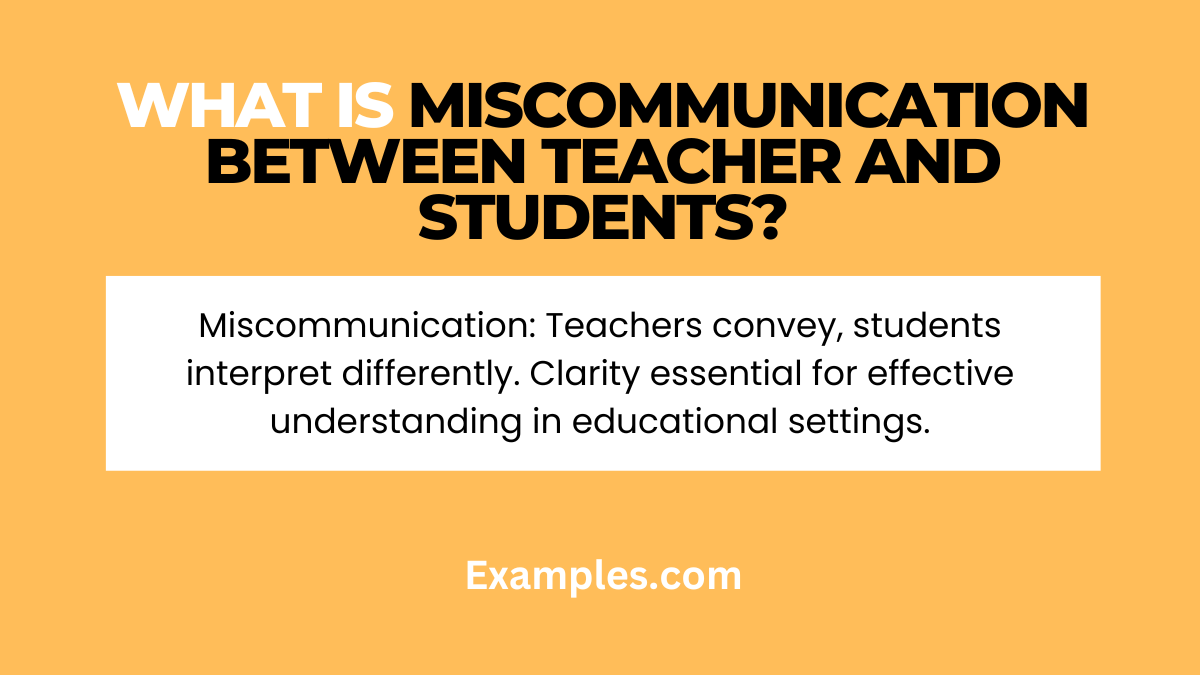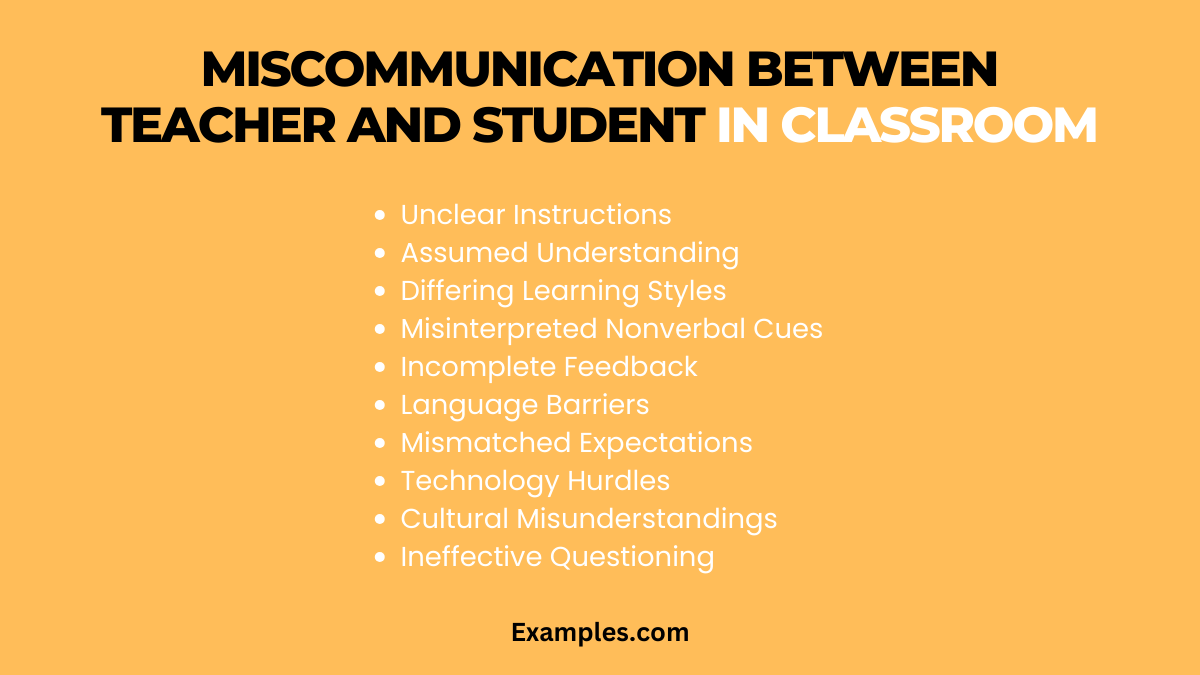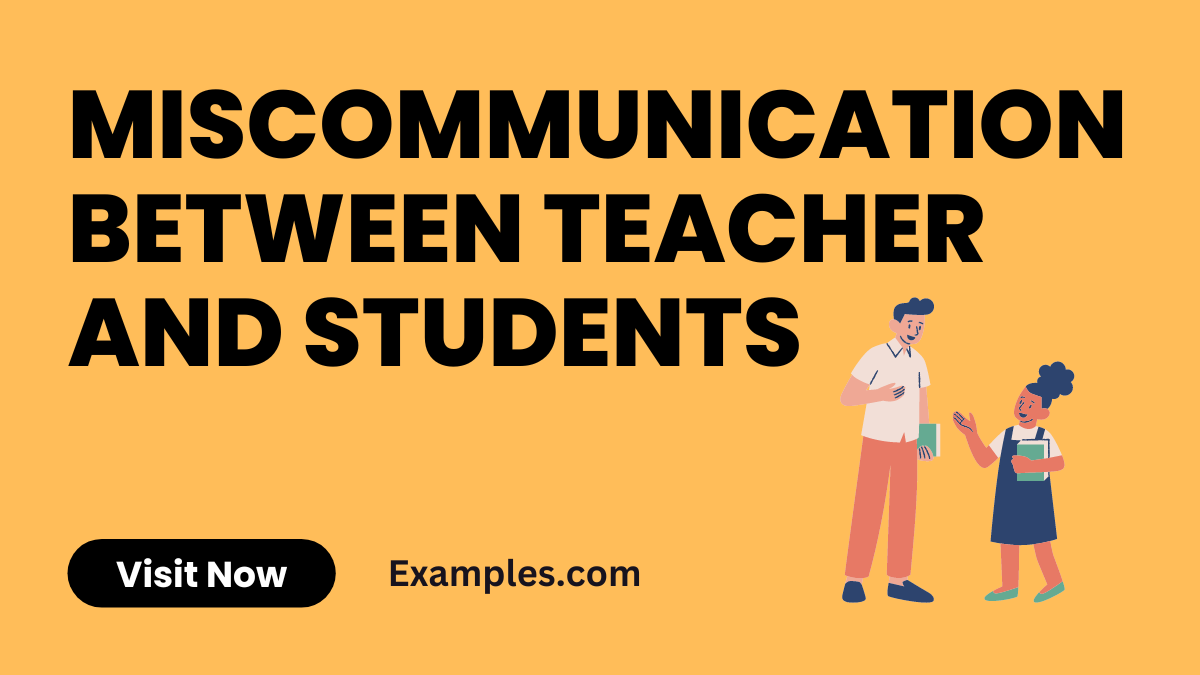9+ Miscommunication between Teacher and Students Examples
Unlock the secrets of effective teacher-student communication with our comprehensive guide on “Miscommunication between Teacher and Students.” This in-depth exploration goes beyond theoretical concepts, offering real-world communication examples to enhance your understanding. From recognizing pitfalls to implementing actionable solutions, dive into a wealth of insights that empower educators and students alike. Navigate the nuances of communication with this insightful guide, ensuring a harmonious and productive learning environment. Learn, adapt, and transform through practical examples in the realm of teacher-student interaction.
What is Miscommunication between Teacher and Students?

Miscommunication between teachers and students refers to a breakdown in understanding, where intended messages are not accurately received or interpreted. In simple terms, it involves a disconnect in communication that can hinder the learning process. This can stem from various factors, such as differing communication styles, unclear instructions, or misinterpreted cues. Understanding the concept is crucial for fostering effective communication in educational settings, promoting a positive and conducive learning environment.
Miscommunication between Teacher and Student in Classroom:

Navigate the complexities of classroom communication to foster a conducive learning environment. Explore potential pitfalls, effective strategies, and real-world examples to enhance teacher-student interactions. Our comprehensive guide sheds light on the nuances of miscommunication, providing valuable insights for both educators and students.
- Unclear Instructions: A teacher intending a project deadline communicates vaguely, leading to student confusion and missed expectations.
- Assumed Understanding: When a teacher assumes prior knowledge, students may feel lost, hindering effective comprehension of new concepts.
- Differing Learning Styles: Students may struggle if teaching methods don’t align with their preferred learning styles, causing a breakdown in communication.
- Misinterpreted Nonverbal Cues: Teachers may unintentionally convey frustration through body language, impacting student confidence and engagement.
- Incomplete Feedback: Lack of detailed feedback can leave students uncertain about their performance and hinder future improvement.
- Language Barriers: Miscommunication arises when language differences between teachers and students impede clear understanding of instructional content.
- Mismatched Expectations: Students and teachers may have different expectations, causing confusion and frustration in the learning process.
- Technology Hurdles: Technical issues during virtual classes can disrupt communication, leading to missed instructions and learning opportunities.
- Cultural Misunderstandings: Diverse backgrounds may lead to misinterpretations, emphasizing the importance of cultural sensitivity in communication.
- Ineffective Questioning: Students may hesitate to seek clarification, fearing judgment, resulting in unresolved doubts and potential learning gaps.
Reasons for Miscommunication Between Students and Teachers:
Delve into the intricacies of communication breakdowns in educational settings. Explore the following factors contributing to miscommunication:
- Diverse Communication Styles: Varied approaches in conveying and interpreting information can lead to confusion. Strive for clarity to bridge these stylistic gaps.Example: The teacher preferred visual aids, while the student responded better to verbal explanations, resulting in miscommunication.
- Technology Distractions: The prevalence of digital distractions can disrupt communication channels. Recognize and manage these distractions for a more focused learning environment.Example: Miscommunication arose when a student misunderstood an assignment due to distraction caused by mobile devices during class.
- Cultural Differences: Diverse cultural backgrounds may influence communication norms. Sensitivity and awareness are key to overcoming these differences.Example: A miscommunication occurred when a cultural nuance led the student to misinterpret a gesture during a discussion.
- Lack of Clarity in Instructions: Unclear instructions can lead to confusion. Enhance clarity by providing detailed and concise guidance.Example: The vague assignment instructions resulted in miscommunication as the student interpreted the requirements differently than intended.
- Assumption and Preconceptions: Assumptions about student knowledge or behavior can hinder effective communication. Address assumptions to foster better understanding.Example: The teacher assumed prior knowledge, leading to miscommunication as the student was unfamiliar with the foundational concepts.
- Overlapping Responsibilities: Clarify roles and responsibilities to avoid misunderstandings regarding expectations and tasks.Example: Miscommunication arose when both the teacher and student assumed the other was responsible for a specific aspect of a collaborative project.
- Ineffective Feedback: Constructive feedback is crucial. Ineffective feedback can result in misunderstandings and hinder academic progress.Example: The student misinterpreted the teacher’s feedback, affecting subsequent assignments due to a lack of clarity in the comments provided.
- Environmental Distractions: External factors like noise or interruptions can disrupt communication. Minimize environmental distractions for more effective interaction.Example: The class miscommunication occurred when external noise caused the student to miss key points during a lecture.
- Mismatched Expectations: Misalignments in expectations between teachers and students can lead to frustration and communication breakdowns.Example: A miscommunication ensued when the teacher expected the student to proactively seek clarification, while the student relied on explicit guidance.
- Limited Use of Visual Aids: Visual aids enhance understanding, and their absence can contribute to miscommunication. Incorporate visuals strategically to reinforce verbal communication.Example: Miscommunication arose when complex concepts were explained verbally without accompanying visual aids, leaving the student struggling to grasp the content
Miscommunication in the classroom: What Teachers Say and What Student Really Hear
Unravel the complexities of classroom communication as we delve into the disparities between teachers’ words and students’ interpretations. Explore the nuances that contribute to miscommunication, fostering a deeper understanding for both educators and learners.
- Teacher Says: “Review the material at your own pace.”
- Student Hears: “The material isn’t important; skip it.”
- Teacher Says: “Ask questions if you’re confused.”
- Student Hears: “Asking questions is a sign of weakness.”
- Teacher Says: “This assignment is straightforward.”
- Student Hears: “No need to put much effort into it.”
- Teacher Says: “Participation is encouraged.”
- Student Hears: “Only extroverts get noticed.”
- Teacher Says: “Be creative with your answers.”
- Student Hears: “Stick to the expected responses.”
- Teacher Says: “We’ll discuss it later.”
- Student Hears: “It’s not important; forget about it.”
- Teacher Says: “Read the instructions carefully.”
- Student Hears: “Just skim through quickly.”
- Teacher Says: “You have freedom in your project.”
- Student Hears: “There’s only one right way to do it.”
- Teacher Says: “We’ll have a brief quiz.”
- Student Hears: “It’s going to be a major exam.”
- Teacher Says: “The due date is flexible.”
- Student Hears: “I can submit it whenever I want.”
What are the Common Causes of Miscommunication between Teachers and Students?

Miscommunication in the educational setting can arise from various factors, impacting the learning experience. Understanding these common causes is pivotal for fostering effective teacher-student communication.
- Differing Communication Styles:
- Teachers and students may have distinct communication preferences, leading to misunderstandings. Recognizing these differences is key to bridging the gap.
- Unclear Expectations:
- Ambiguous instructions or unclear expectations can contribute to miscommunication. Clarity in conveying expectations enhances understanding.
- Cultural and Language Variances:
- Diverse backgrounds bring varying communication norms. Acknowledging cultural and language differences promotes a more inclusive learning environment.
- Assumed Knowledge:
- Teachers may assume students possess certain background knowledge, resulting in confusion. Clear articulation of prerequisites is crucial for effective communication.
- Nonverbal Cues Misinterpretation:
- Nonverbal communication plays a significant role. Misinterpreting gestures, expressions, or body language can lead to communication breakdowns.
In conclusion, this comprehensive guide unveils the intricacies of miscommunication between teachers and students, offering real-world examples and actionable insights. By navigating through practical scenarios and implementing effective communication strategies, educators can bridge gaps, fostering a positive and productive learning environment. Embrace the wisdom gained to enhance communication dynamics in the classroom, ensuring a harmonious educational experience for all.



